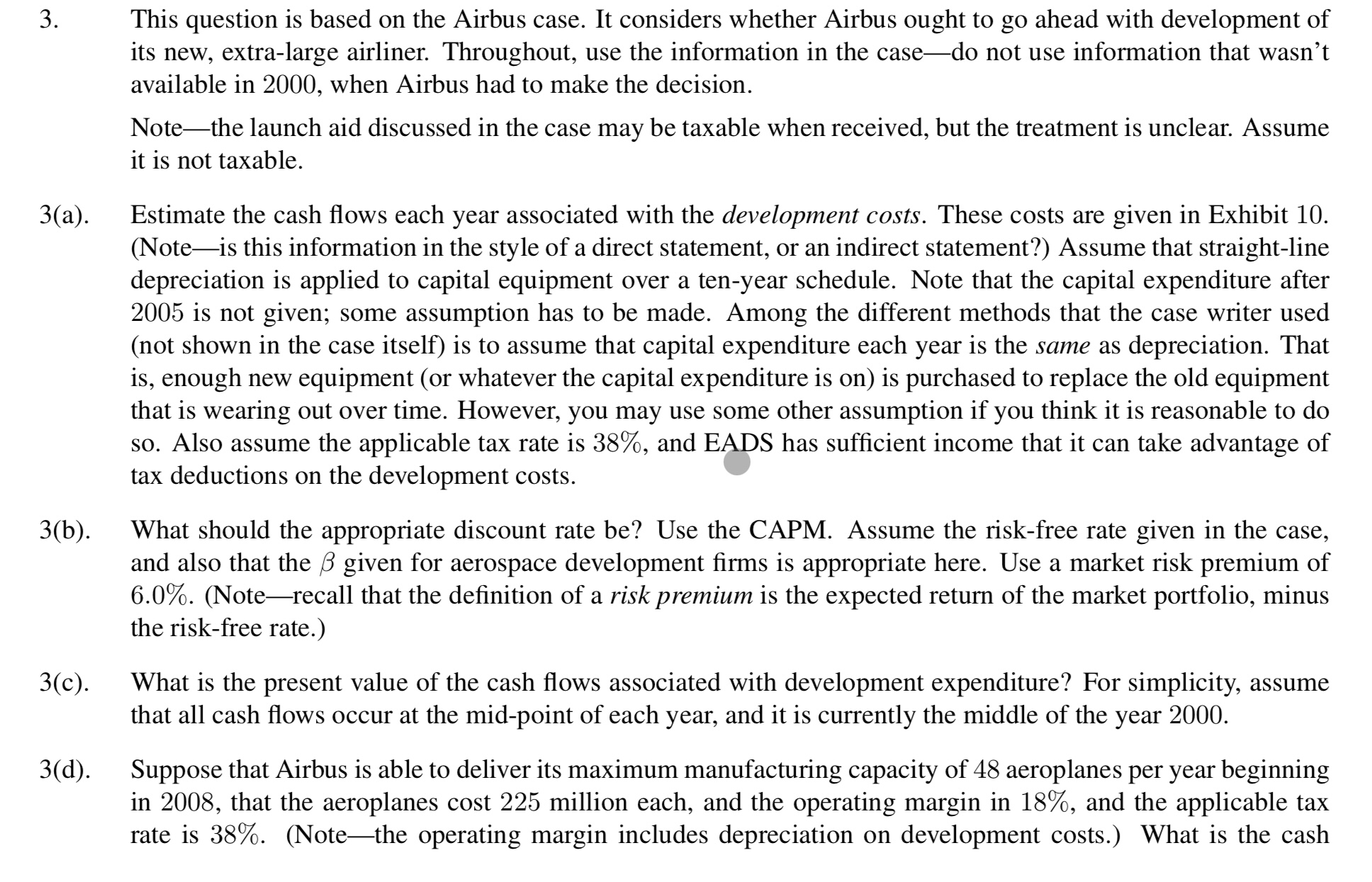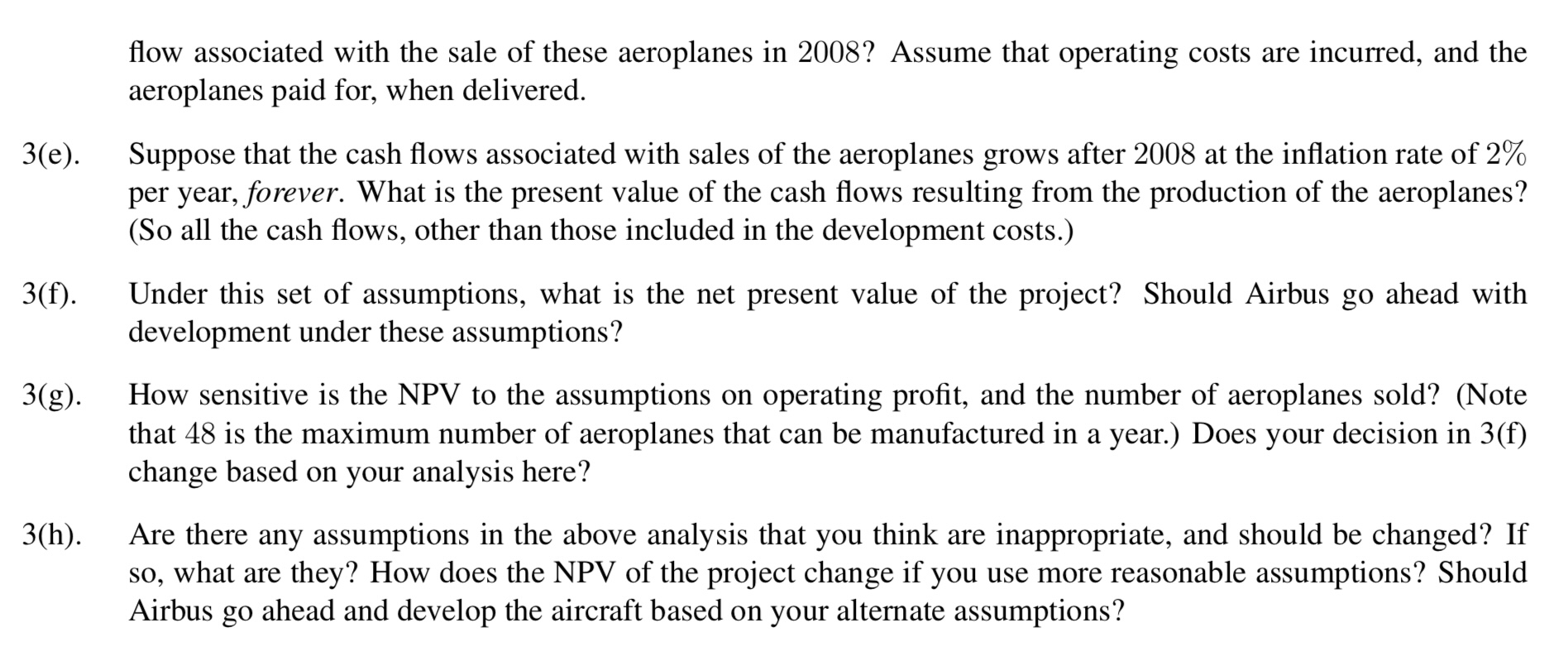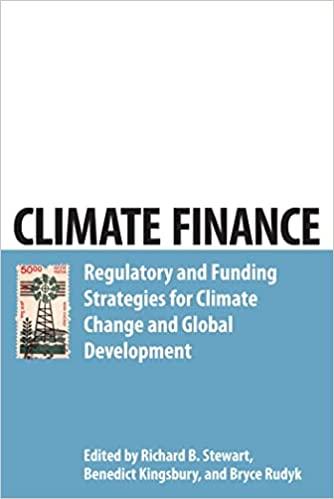Answered step by step
Verified Expert Solution
Question
1 Approved Answer
This question is based on the Airbus case. It considers whether Airbus ought to go ahead with development of its new, extra-large airliner. Throughout, use

 This question is based on the Airbus case. It considers whether Airbus ought to go ahead with development of its new, extra-large airliner. Throughout, use the information in the case-do not use information that wasn't available in 2000, when Airbus had to make the decision. Note- the launch aid discussed in the case may be taxable when received, but the treatment is unclear. Assume it is not taxable. (a). Estimate the cash flows each year associated with the development costs. These costs are given in Exhibit 10. (Note-is this information in the style of a direct statement, or an indirect statement?) Assume that straight-line depreciation is applied to capital equipment over a ten-year schedule. Note that the capital expenditure after 2005 is not given; some assumption has to be made. Among the different methods that the case writer used (not shown in the case itself) is to assume that capital expenditure each year is the same as depreciation. That is, enough new equipment (or whatever the capital expenditure is on) is purchased to replace the old equipment that is wearing out over time. However, you may use some other assumption if you think it is reasonable to do so. Also assume the applicable tax rate is 38%, and EADS has sufficient income that it can take advantage of tax deductions on the development costs. b). What should the appropriate discount rate be? Use the CAPM. Assume the risk-free rate given in the case, and also that the given for aerospace development firms is appropriate here. Use a market risk premium of 6.0%. (Note-recall that the definition of a risk premium is the expected return of the market portfolio, minus the risk-free rate.) (c). What is the present value of the cash flows associated with development expenditure? For simplicity, assume that all cash flows occur at the mid-point of each year, and it is currently the middle of the year 2000. (d). Suppose that Airbus is able to deliver its maximum manufacturing capacity of 48 aeroplanes per year beginning in 2008 , that the aeroplanes cost 225 million each, and the operating margin in 18%, and the applicable tax rate is 38%. (Note - the operating margin includes depreciation on development costs.) What is the cash flow associated with the sale of these aeroplanes in 2008? Assume that operating costs are incurred, and the aeroplanes paid for, when delivered. (e). Suppose that the cash flows associated with sales of the aeroplanes grows after 2008 at the inflation rate of 2% per year, forever. What is the present value of the cash flows resulting from the production of the aeroplanes? (So all the cash flows, other than those included in the development costs.) (f). Under this set of assumptions, what is the net present value of the project? Should Airbus go ahead with development under these assumptions? (g). How sensitive is the NPV to the assumptions on operating profit, and the number of aeroplanes sold? (Note that 48 is the maximum number of aeroplanes that can be manufactured in a year.) Does your decision in 3(f) change based on your analysis here? (h). Are there any assumptions in the above analysis that you think are inappropriate, and should be changed? If so, what are they? How does the NPV of the project change if you use more reasonable assumptions? Should Airbus go ahead and develop the aircraft based on your alternate assumptions
This question is based on the Airbus case. It considers whether Airbus ought to go ahead with development of its new, extra-large airliner. Throughout, use the information in the case-do not use information that wasn't available in 2000, when Airbus had to make the decision. Note- the launch aid discussed in the case may be taxable when received, but the treatment is unclear. Assume it is not taxable. (a). Estimate the cash flows each year associated with the development costs. These costs are given in Exhibit 10. (Note-is this information in the style of a direct statement, or an indirect statement?) Assume that straight-line depreciation is applied to capital equipment over a ten-year schedule. Note that the capital expenditure after 2005 is not given; some assumption has to be made. Among the different methods that the case writer used (not shown in the case itself) is to assume that capital expenditure each year is the same as depreciation. That is, enough new equipment (or whatever the capital expenditure is on) is purchased to replace the old equipment that is wearing out over time. However, you may use some other assumption if you think it is reasonable to do so. Also assume the applicable tax rate is 38%, and EADS has sufficient income that it can take advantage of tax deductions on the development costs. b). What should the appropriate discount rate be? Use the CAPM. Assume the risk-free rate given in the case, and also that the given for aerospace development firms is appropriate here. Use a market risk premium of 6.0%. (Note-recall that the definition of a risk premium is the expected return of the market portfolio, minus the risk-free rate.) (c). What is the present value of the cash flows associated with development expenditure? For simplicity, assume that all cash flows occur at the mid-point of each year, and it is currently the middle of the year 2000. (d). Suppose that Airbus is able to deliver its maximum manufacturing capacity of 48 aeroplanes per year beginning in 2008 , that the aeroplanes cost 225 million each, and the operating margin in 18%, and the applicable tax rate is 38%. (Note - the operating margin includes depreciation on development costs.) What is the cash flow associated with the sale of these aeroplanes in 2008? Assume that operating costs are incurred, and the aeroplanes paid for, when delivered. (e). Suppose that the cash flows associated with sales of the aeroplanes grows after 2008 at the inflation rate of 2% per year, forever. What is the present value of the cash flows resulting from the production of the aeroplanes? (So all the cash flows, other than those included in the development costs.) (f). Under this set of assumptions, what is the net present value of the project? Should Airbus go ahead with development under these assumptions? (g). How sensitive is the NPV to the assumptions on operating profit, and the number of aeroplanes sold? (Note that 48 is the maximum number of aeroplanes that can be manufactured in a year.) Does your decision in 3(f) change based on your analysis here? (h). Are there any assumptions in the above analysis that you think are inappropriate, and should be changed? If so, what are they? How does the NPV of the project change if you use more reasonable assumptions? Should Airbus go ahead and develop the aircraft based on your alternate assumptions Step by Step Solution
There are 3 Steps involved in it
Step: 1

Get Instant Access to Expert-Tailored Solutions
See step-by-step solutions with expert insights and AI powered tools for academic success
Step: 2

Step: 3

Ace Your Homework with AI
Get the answers you need in no time with our AI-driven, step-by-step assistance
Get Started


